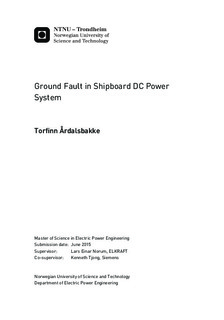| dc.description.abstract | The report first present the ship considered in the task. The theory part of the thesis gives a short introduction to dynamic positioning and the requirements the different DPS classes puts on the ship. Then the principal buildup of different grounding configurations is explained. A short presentation of the difference between ground faults in AC and DC systems is given before different methods for detecting ground faults in the different systems are presented. The last chapter in the theory part address the protection systems ability to handle ground faults and short circuits.
When designing the simulation model some simplifications where made. The model is not a complete replica of the bus defined by Siemens. The model consists of enough components to create a representative model of the system. A larger model is unnecessary large and complex. In order to reduce complexity of the model, no dynamic components are used. When removing dynamic components, the system becomes very stable in normal operations even during short simulations.
The main concern for this thesis is how the first ground fault in different part of the system affect the normal operation of the system. Concerns related to how a ground fault on the AC side affect the DC bus and further the AC side of different inverters are put forth.
Simulations show that the first ground fault would not affect normal operation of the system. The only effect is that the voltage stress across the insulation increases. The report also show that a second ground fault anywhere else in the system would give a large fault current that affect normal operation of the system.
If a ground fault have occurred, detection that there actually is a fault somewhere in the system is easy. Locating and clearing or reducing the probability of a sub-sequent fault is much harder. Detection can be done by monitoring the voltage between the phases and ground on the DC bus. If one phase collapse to ground or the voltage ripple is from zero to phase-phase voltage, a fault is present in the system. In this case, it is important to localize and clear, or reduce the probability of a second ground fault from occurring in the same electric zone as soon as possible. This report present different technique for locating ground faults in the system. Presentation of how the system could locate ground faults to different degrees of precision is also suggested. Further, it is recommended that the system take action in order to reduce the chance of a second fault occurring in the same electrical zone as the first. This can be done by isolating the faulty bus from the rest of the system.
An analyze of what grounding system is more feasible in this type of vessel is presented. The analyze takes in mind the different strengths and weaknesses of the different grounding schemes and compare them to the most important operational requirements of the vessel. Since the most important feature is operational reliability, the IT system is considered the most suitable grounding system for this type of vessel. | |

